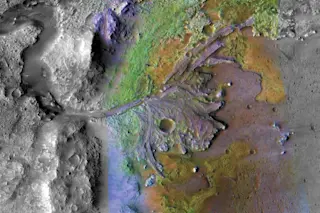Scientists have found another reason to look forward to NASA's next Mars rover mission. A spacecraft orbiting Mars recently spotted clear signs that the landing site for NASA’s Mars 2020 rover — Jezero Crater — is home to hydrated silica, a mineral that’s particularly good at preserving signs of life. That could make the landing site a good place to preserve .
The rover mission will help researchers figure out how the minerals formed and start probing them for signs of life. And a team of scientists is already proposing several ideas for how the minerals came to be in Jezero Crater. The researchers describe their findings in a study published in November in the journal Geophysical Research Letters.
Silica is a crystalline structure made of silicon and oxygen that can be found in quartz, glass and sand. Hydrated silica holds water within its crystal structure. On Earth, hydrated silica ...














